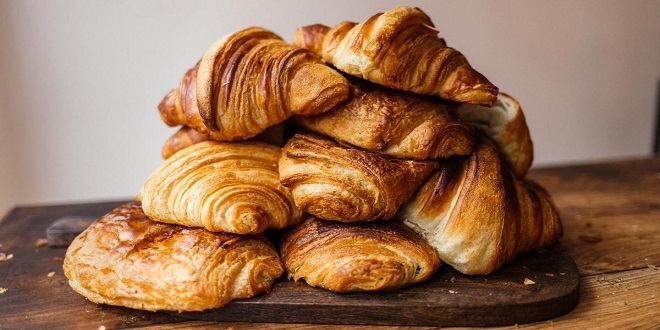The croissant, with its flaky layers and buttery aroma, is a quintessential French pastry that has captured the hearts and palates of food lovers around the world. Originating in France in the early 19th century, the croissant has since become a symbol of French culinary excellence and a beloved breakfast treat enjoyed by millions. Join us as we embark on a delectable journey to discover the history, craftsmanship, and irresistible allure of the croissant.
The Origins of the Croissant: A Tale of Viennese Inspiration
Contrary to popular belief, the croissant’s origins can be traced back to Vienna, Austria, rather than France. The pastry known as “kipferl” or “kipfel” was introduced to France in the late 1830s by Austrian bakers yoktogel, who brought their expertise in laminated dough to Parisian bakeries. Over time, French bakers refined and perfected the recipe, transforming the kipferl into the crescent-shaped croissant that we know and love today.
Crafting the Perfect Croissant: A Labor of Love
Creating the perfect croissant is no easy feat and requires a delicate balance of technique, precision, and patience. The process begins with the preparation of laminated dough, a labor-intensive process that involves layering butter between thin sheets of dough and repeatedly folding and rolling it to create the signature flaky layers. The dough is then shaped into crescents, proofed until light and airy, and baked to golden perfection. The result is a croissant that boasts a crispy exterior, tender interior, and irresistible buttery flavor.
Variations of the Croissant: Exploring Flavors and Fillings
While the classic croissant is a culinary masterpiece in its own right, pastry chefs and bakers around the world have put their own spin on this beloved pastry, creating a variety of unique flavors and fillings to tantalize the taste buds. From chocolate-filled croissants to almond-flavored variations, there’s no shortage of delicious options to choose from. Additionally, savory croissants filled with cheese, ham, or vegetables offer a delightful alternative for those craving something savory.
The Croissant’s Cultural Significance: A Symbol of French Culinary Heritage
In France, the croissant holds a special place in culinary culture and is synonymous with the art of baking and pastry-making. It is a staple of French breakfasts and brunches, often enjoyed alongside a café au lait or freshly squeezed orange juice. The croissant’s cultural significance extends beyond France’s borders, with bakeries and cafes around the world paying homage to this iconic pastry. Whether enjoyed as a simple pleasure or as part of a lavish meal, the croissant embodies the spirit of French gastronomy and craftsmanship.
Health Considerations: Balancing Indulgence with Moderation
While undeniably delicious, croissants are also rich in butter and calories, making them a treat best enjoyed in moderation. However, with the rise of health-conscious consumers, bakeries and pastry shops have begun offering lighter versions of the classic croissant, made with whole grains or alternative flours and reduced-fat butter. These healthier alternatives provide a guilt-free option for those looking to indulge in the buttery goodness of a croissant without compromising their dietary goals.
The Croissant’s Global Appeal: From Paris to Patisseries Everywhere
Despite its French origins, the croissant’s popularity knows no bounds and can be found in bakeries, cafes, and supermarkets around the world. From New York to Tokyo, the croissant has become a ubiquitous pastry enjoyed by people of all ages and backgrounds. Its versatility and adaptability have contributed to its global appeal, with chefs and home bakers incorporating the croissant into a wide range of sweet and savory dishes, from sandwiches and tartines to bread pudding and ice cream sandwiches.
Innovation in Croissant-Making: Pushing the Boundaries of Tradition
While the classic croissant remains a timeless favorite, innovation in croissant-making has led to the creation of new and exciting variations that push the boundaries of tradition. Pastry chefs are experimenting with alternative flours, unconventional fillings, and innovative shaping techniques to reinvent the croissant and offer unique flavor experiences to their customers. Whether it’s a matcha-infused croissant or a croissant stuffed with exotic fruits, these creative interpretations breathe new life into this beloved pastry.
Embracing the Timeless Appeal of the Croissant
the croissant stands as a testament to the artistry, craftsmanship, and cultural heritage of French pastry-making. From its humble origins in Vienna to its global popularity today, the croissant has remained a beloved symbol of indulgence and sophistication. Whether enjoyed as a simple pleasure with a cup of coffee or as part of a gourmet meal, the croissant continues to captivate the senses and delight food lovers around the world with its flaky layers, buttery flavor, and irresistible charm.
Exploring Croissant Culture and Etiquette
Beyond its delectable taste and rich history, the croissant also carries with it a set of cultural norms and etiquette that add to its allure. In France, where the croissant is a staple of daily life, there are certain rituals and traditions associated with its consumption. For instance, it is customary to enjoy a croissant fresh from the bakery, preferably while it is still warm from the oven. Additionally, the proper way to eat a croissant is to tear off small pieces rather than cutting it with a knife, allowing you to savor each flaky layer and buttery bite.
From Boulangeries to Michelin-Starred Restaurants
While the croissant may have humble beginnings as a simple breakfast pastry, it has also found its way onto the menus of some of the world’s most prestigious dining establishments. In recent years, chefs at Michelin-starred restaurants have elevated the croissant to new heights, incorporating it into innovative and sophisticated dishes that showcase its versatility and culinary potential. From croissant-based desserts to savory croissant creations, these gourmet interpretations demonstrate the enduring appeal of this iconic pastry.
The Croissant’s Role in Global Cuisine: Fusion Flavors and Cross-Cultural Influences
As the croissant has traveled the globe, it has been embraced by chefs and home cooks from diverse culinary backgrounds, leading to the emergence of fusion flavors and cross-cultural influences. In cities like New York, London, and Tokyo, you’ll find croissants infused with flavors from around the world, such as matcha, black sesame, and kimchi. These multicultural interpretations of the classic croissant reflect the increasingly global nature of food culture and the endless possibilities for culinary creativity.
The Future of the Croissant: Innovation and Evolution
Looking ahead, the future of the croissant promises continued innovation and evolution as chefs and bakers push the boundaries of traditional pastry-making. With advancements in technology and techniques, we can expect to see new and exciting variations of the croissant emerge, from gluten-free and vegan options to digitally printed croissants customized to individual preferences. While the classic croissant will always hold a special place in our hearts, these innovations pave the way for a new era of croissant-making that celebrates creativity, sustainability, and inclusivity.
Celebrating the Timeless Appeal of the Croissant
the croissant remains a timeless symbol of indulgence, sophistication, and culinary craftsmanship. From its humble origins in Vienna to its global popularity today, the croissant has captured the hearts and palates of food lovers around the world with its flaky layers, buttery flavor, and irresistible charm. Whether enjoyed as a simple pleasure or as part of a gourmet dining experience, the croissant continues to inspire and delight, reminding us of the joy that can be found in the simple pleasures of life.



